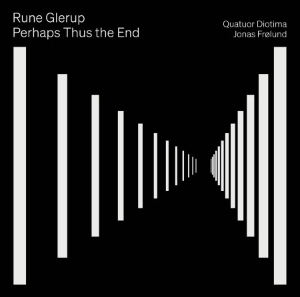
Rune Glerup (b. 1981)
Perhaps Thus The End
String Quartet No 2, Op 19, Perhaps Thus the End (2017)
Clarinet Quintet, Op 16, Still Leaning Towards This Machine (2015)
Quatuor Diotima
Jonas Frølund (clarinet)
rec. 2019, Baden-Baden, Germany
All first recordings
Reviewed from download
Dacapo 8.224763 [56]
Rune Glerup is a Danish composer working with instrumental, electro-acoustic and electronic music. His website states, “He has especially become known for an almost sculptural approach to composition, focusing on the beauty of the musical material itself, rather than using music as a metaphorical language.” His approach was first heard in the work objets/décalages – 2008, Dacapo Records 8.226578. This was followed by a disc entitled Dust encapsulated – 2009 Dacapo Records 8.226578. He has gone on to write a Piano Concerto for Ensemble intercontemporain, a violin concerto for Isabelle Faust and a Piano Trio for Trio Con Brio Copenhagen. String Quartet No. 2, Op. 19, Perhaps Thus the End (2017) which features on the CD , was commissioned by the Diotima Quartet, who play it on this recording, and Westdeutscher Rundfunk with support from the Danish Arts Foundation.
The second piece on the CD is the clarinet quintet, for clarinet, string quartet and live-electronics;this also features the Diotima Quartet along with the clarinettist Jonas Frølund. The Diotima Quartet are a French quartet who specialise in 20th Century music, they have commissioned and performed many new works. Jonas Frølund is a Danish clarinettist currently pursuing a career as soloist and chamber musician besides his engagements in The Danish Chamber Orchestra as Principal Clarinet and Chairman and in the rising wind quintet V Coloris as clarinettist and co-founder.
I am always fascinated by where composers gain their inspiration and the processes they follow to create their pieces. The CD brochure does refer to the inspiration for both pieces but spends considerable time describing the approach taken by Glerup to compose his music. To quote just two short phrases used, “Rune Glerup applies the rubric normally employed by visual artists and sculptors to the discipline of composing notated and electroacoustic music”, and, “He is interested in sound conceived as an almost physical structure – in material stripped of descriptive or dynamic qualities, relying instead on its own concrete and constant properties and the vibration, resonance, attraction or unease drawn from those properties when placed in the presence of other, equally clearly defined material.” So what does that mean for the music we can hear?
Glerup’s String Quartet No. 2 Perhaps Thus the End has seven titled but linked movements. The spirit of the Irish novelist Samuel Beckett (1906–89) is quoted as the inspiration for the piece i.e. the writer’s fixation on existence, meaning, the passing of time and the cessation of things. The whole piece has a nervous energy and a tendency to place wholly different ideas, materials or traditions in close proximity to one another to create energising and unexpected musical effects. At the start of the work’s opening movement, itself titled ‘Perhaps Thus the End’ and marked ‘leggiero, sotto voce’, a motif is played softly and lightly and is shared among all four players. The second movement, ‘Now to Press on Regardless,’ is marked ‘agitato, assurdo’, and is crammed with intricate, rococo gestures including scrunched notes and glissandi; it’s dramatic and full of energy. The third movement ‘From Deep Within’ is marked ‘poco espressivo, leggiero’. The CD brochure tells us, “It offers perhaps the purest example of Glerup’s concept of concrete musical objects existing together but with autonomy, as the florid structures from before are now aerated, separated by held chords as if to resemble statues arranged apart from one another in a gallery.” Again, it’s played lightly and in an airy fashion which I found to be peaceful and soothing. The fourth movement, ‘The Dark of Night or Day’ is a ‘tranquillo’, it’s a peaceful, quiet and calming nocturne before the fifth, ‘The Then Fleeting Dark of Night,’ which opens with a fugue, directly mimicking the ‘fleeting’ dark of night. It, too, is played in a light way but perhaps has a little more energy than the preceding two tracks. Movement six, ‘The Strokes and Cries as Before,’ returns us to the material and atmosphere of the second movement, but now played at a brisker pace, before the work concludes with the seventh movement, ‘The End, Again and Again,’ a prolonged version of the work’s introduction, which is tentative and tense. All in all, I was pleasantly surprised by the whole piece.
The clarinet quintet was first performed on 14 March 2015 in Orléans by the Diotima Quartet and clarinettist Alain Billard. The CD booklet informs us, “The piece operates to Glerup’s own principles of musical objects but nods in the direction of some musical developments, composers and scores that have shaped his music from the start”. The work’s title is paraphrased from the poet Charles Bukowski (1920–94) – specifically, the line in his poem Congrats, Chinaski: ‘I am still here, leaning towards this machine.’ Woven into the three movements are electronic elements, downsized to chamber scale for discretion using transducers mounted on instruments, meaning those electronic elements we dohear appear to operate within the same acoustic limitations as the instruments themselves. The first movement bursts with tension and drama, fragments of music played frantically giving us differing tonal colours throughout. The second movement is less dense in terms of motifs heard and slower; however, a steady sense of rhythm is apparent. The third returns to a high speed; the music is frenzied and tense, slowing at the end to a calmer pace.
If you are looking for harmony and easily accessible melodies, this CD probably isn’t for you but it’s very well played and full of emotion.
Ken Talbot
Buying this recording via a link below generates revenue for MWI, which helps the site remain free




















